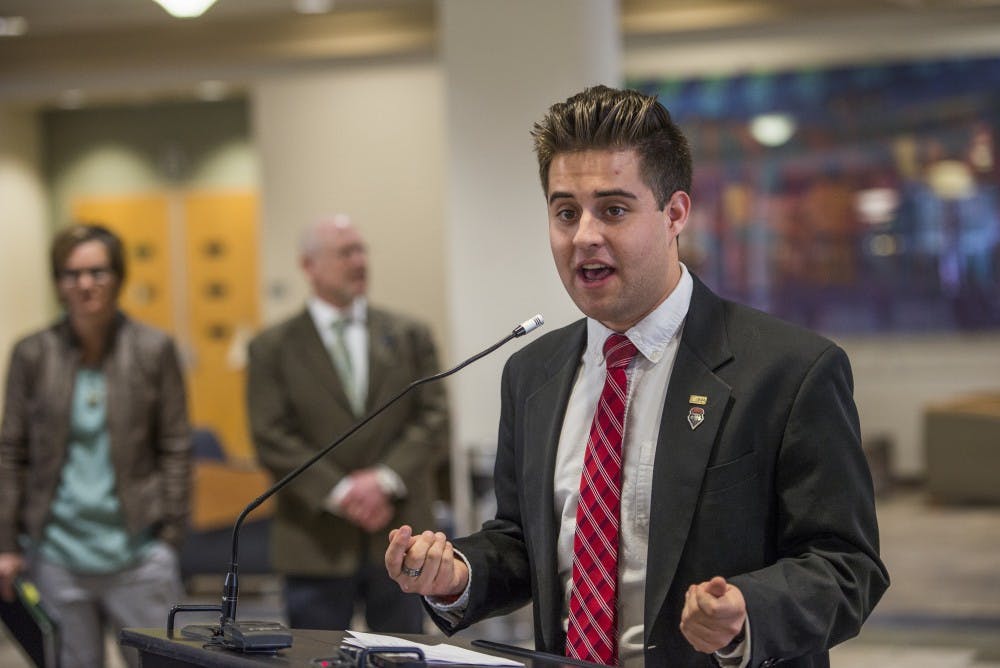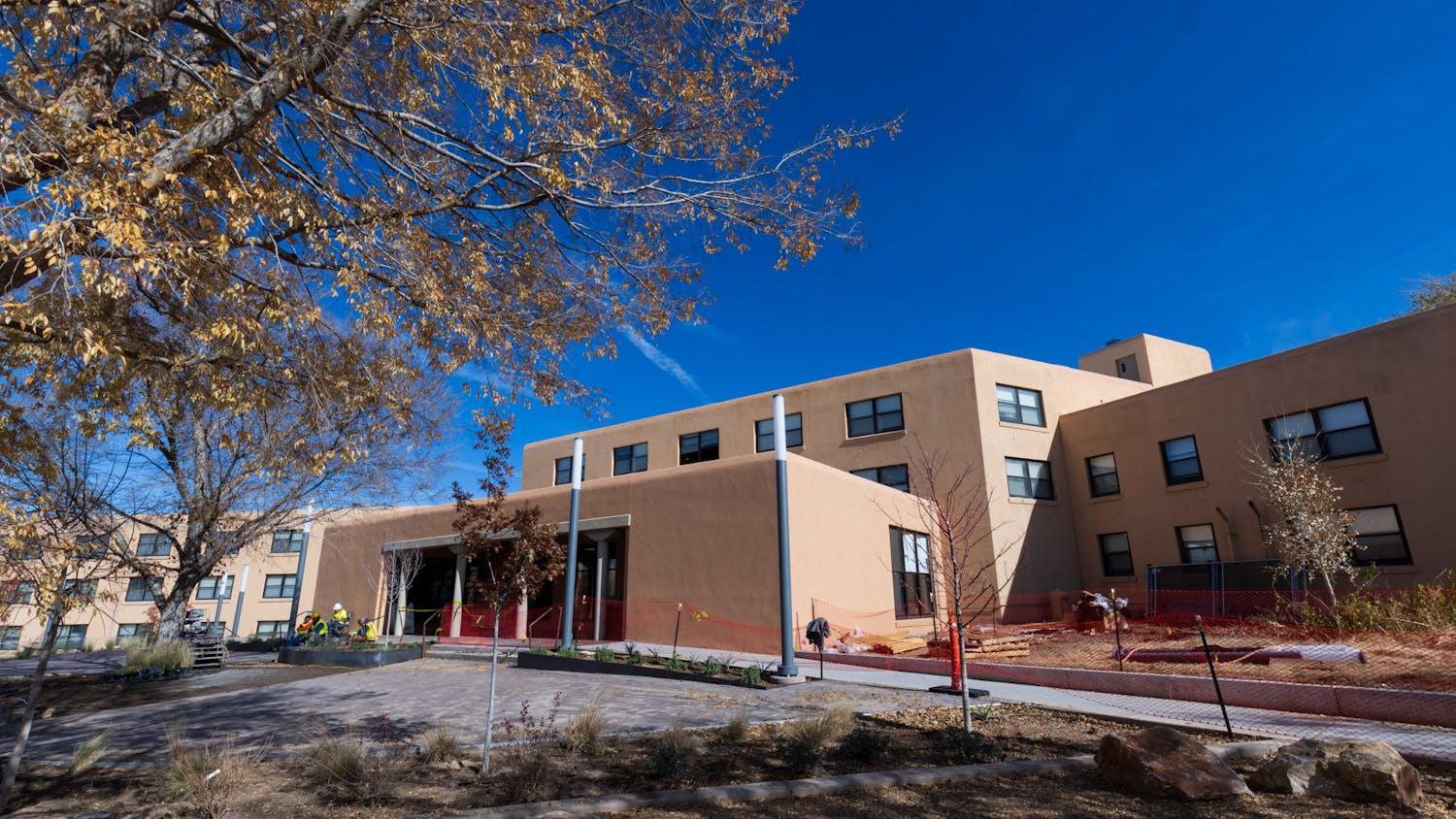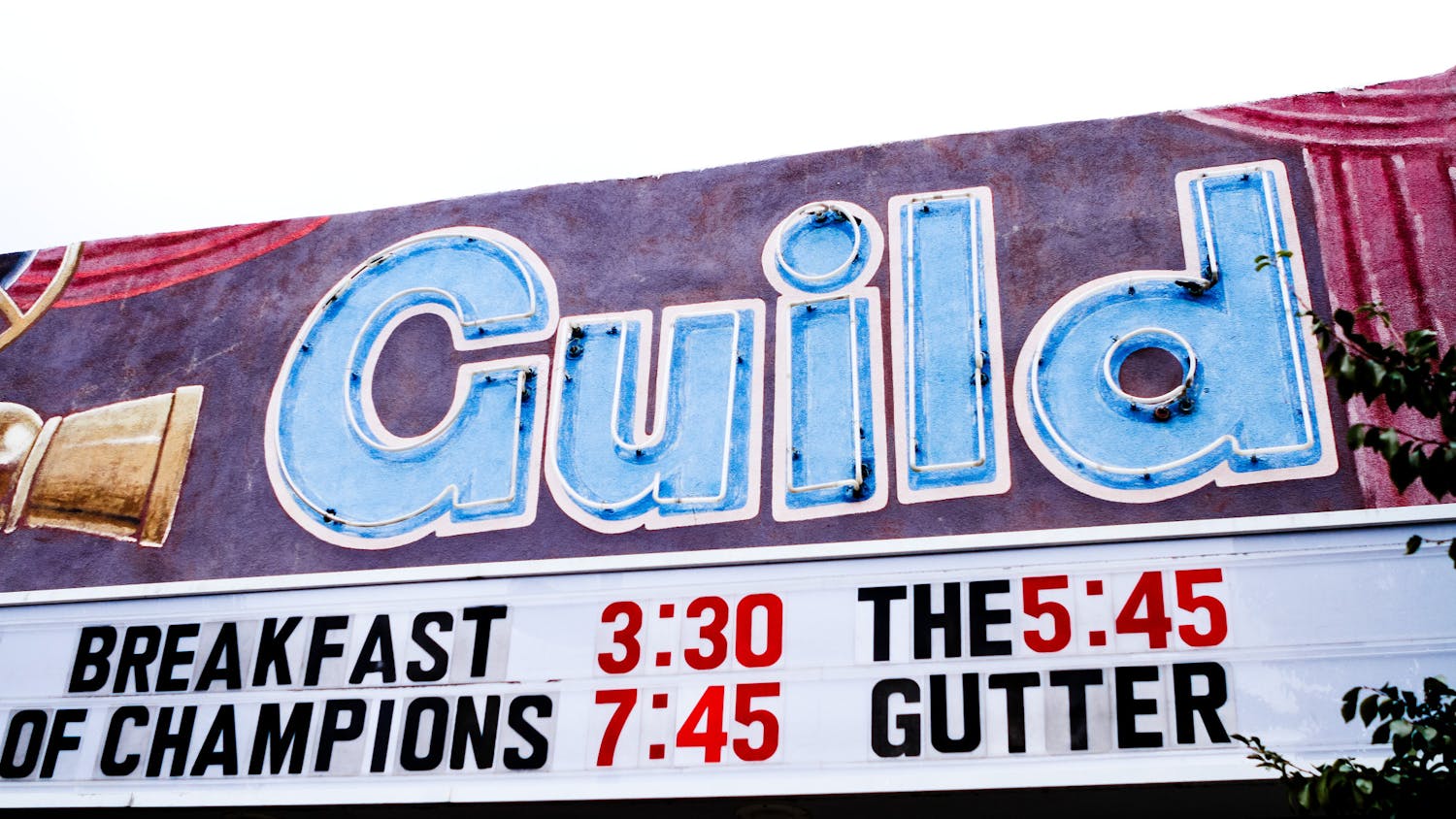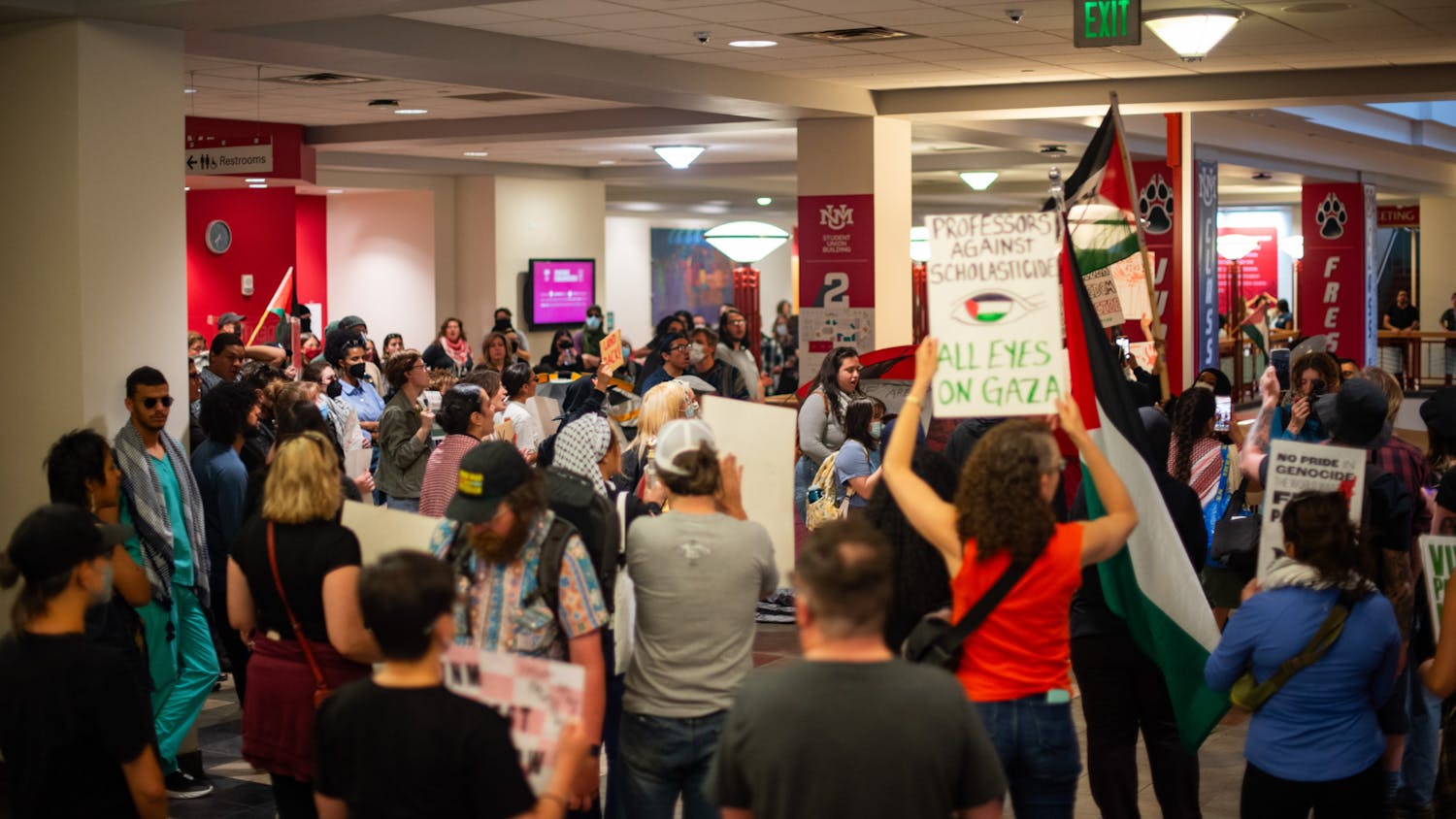Two weeks before the end of his term as Associated Students of UNM President, Kyle Biederwolf has a spotless desk. He’s wearing his characteristic cheery demeanor and an ASUNM T-shirt with a shade of red that almost blends him into the similarly-colored wall behind him. His suit jacket is draped over his chair.
A year after being elected to his office, Biederwolf looks like he’s without battle scars, but anyone who’s been paying attention knows too much has happened — and continues to unfold — at the University for that to be the case.
“One week, six days, 23 hours and 55 minutes,” is exactly how much longer Biederwolf said he has as president on the cold, rainy afternoon when I met him in his ASUNM office. It’s a humorous gesture more than a signal of someone who hasn’t appreciated the opportunity to serve as President, having also served two terms as ASUNM Senator.
But right now, Biederwolf’s priority is assisting in the transition of the executive leadership to ASUNM President-elect Noah Brooks and his team. In the midst of that work, I talked with him about the interesting year UNM has had, and his role in being the voice of the student body during the past 12 months.
DL: So, budget crisis. Lottery scholarship solvency mess. Controversial speakers. How are you feeling after a year?
KB: Oh man, you know... I, and in the best way possible, had no clue what I was getting myself into. The experience that I had in ASUNM I thought would’ve molded me to be the ideal presidential candidate having experience both in the legislative and executive side of things. But you don’t really know what you’re getting yourself into until you step into these shoes and see how much it is.
I think there have been a lot of things happen this year, like you said. The budget crisis is awful. The conservative speakers, the changing of the seal, basically everything. How I feel about all that is: I feel good, because I think that we as an administration did the best that we could do to always have a strong student voice in every single one of these issues, whether it be on the budget leadership team talking about the budget, whether it be meetings with (acting) President (Chaouki) Abdallah talking about these speakers and understanding how to work with student groups on both sides. But I think the strongest thing is that there was always a student voice in all these decisions.
DL: You and ASUNM Vice President Cheyenne Feltz ran on different slates, with different running mates last year. What was it like working with someone who ran on a different platform?
KB: It was very interesting; I think it was the first time in a couple years that there was a split between the two leadership positions. Fortunately, Cheyenne and I had worked in ASUNM together in various capacities, and we were friends outside of the office, so the transition wasn’t hard.
One of the first things we did was we sat down and said, “Alright, we ran on two different platforms, what can we get done this year?” Our relationship definitely developed over the entire year; we learned a lot about each other and a lot about ASUNM. But I don’t think there was ever a problem, which was nice. When you don’t run with someone and the other person wins, it’s always a question mark. You’re not completely sure what’s going to go on, but I would say that the relationship was successful.
DL: There were a lot of students upset this year. The backlash over the ski team being cut, the Milo visit, the official seal, like you mentioned. What did that level of constant engagement by students tell you about the student body this year?
KB: It tells me that the students are realizing that they can make change. And that’s a beautiful thing, because at an institution this large, sometimes students feel like (they’re at) the bottom of the totem pole. I think that the organization of students coming together against different things happening at the University kind of shows that the students do understand that they can make substantial change.
Get content from The Daily Lobo delivered to your inbox
DL: So, obviously, ASUNM works first and foremost for those students. Were there ever any instances over the course of your term where you realized it’s not that black-and-white, where you’d have to, on certain issues, disagree with a certain group of students?
KB: Yeah. I think that every single issue that faces the University will never have a black-and-white answer. Which is unfortunate. (Being a student leader at) UNM would be so much easier if there was an answer to every single question asked, and unfortunately, sometimes you do have to go against other students.
But I think the thing that we did most beautifully this year is that we were able to take these ideas and we were able to present them and present all of the facts, both sides of whatever it may be, and base our student opinion through that.
In positions of power and positions of leadership, you’re never going to make everyone happy. But I think the one thing we did successfully this year is (that) we understood that we weren’t making everybody happy, but we wanted to find out what the overarching feel of the students was. Sometimes that didn’t make us in this office happy, the decision that had to go out and advocate, but that is our job — to advocate what a majority of the students are feeling.
We were never shying away from saying, “There’s a split in this. People feel too strongly both ways and we don’t have an opinion.” That was never really a cop-out answer, but we were able to use that. Being able to sometimes stand in front of these people and say, “Hey, we’re split right now, we don’t know exactly what we’re doing” can sometimes be beneficial.
DL: What do you think are the biggest non-financial challenges facing President-elect Brooks and Vice President-elect Sally Midani? So, tossing the budget and lottery messes out the window...
KB: If you throw finances out, it’s going to be the issue that ASUNM faces year after year after year, and that’s sufficiently representing students. This year, we took a huge step forward in that. From the feedback we heard this year, students are starting to feel represented, but we are not even close to where we need to be. So I think that that’s going to be the biggest challenge, but I have full faith in the next administration that they’re going to take the precedent that we started and push it to the next level.
DL: You having served as a senator and then on the executive team, basically being part of ASUNM for the majority of your collegiate career, do you think that ASUNM has done all it can do in that regard? Or is it now more up to the students to make sure they’re engaged and in tune with what’s going on in student government?
KB: I think that ASUNM hasn’t done everything that we can. Over the last three years, we’ve always taken steps forward, and I want to give praise to the presidents that I’ve seen, as well as our administration, because we are taking steps forward. But we’re not close to where we need to be. It’s a problem when only eight percent of your student body votes in your senator elections that represent students and student voices.
But I think that we did take larger steps forward this year, with the Joint Council, with all the outreach that we did over big University issues that were facing the regents. As people step forward, and as new administrations come in, the Joint Council’s going to become even more and more prevalent to making decisions on students’ behalf.
DL: With the new UNM logo coming out literally hours ago, I feel like this is a really appropriate time to ask this: Do you think the identity of UNM is going to be different five years from now than it is right now?
KB: I’m going to answer as ASUNM president, but I’m also going to answer as a marketing student at Anderson. I think that this branding initiative has the opportunity to change UNM. And it’s weird, because if you tell that to someone other than a communication or marketing major that doesn’t understand the logistics that way, it’s a weird issue to talk about — how a brand identity can change an entire university. But it really can.
This entire year, we’ve just been pushing, “Each of us defines all of us,” (the UNM branding campaign), and I think that really encompasses what UNM is. We take pride in our diversity, and we take pride in the university that we are, with the students and the faculty and the staff and the administration that we have. And I think that this branding initiative, it’s a lot more modern and it has the opportunity to put our University on the map, and internationally.
I’m excited for it, and hopefully it changes the culture of UNM over the next five, 10, 15 years to more of a modern campus and more of a destination university.
DL: With all the things we mentioned earlier, the big issues going on and the different controversies on campus that students are so passionate about...in your view, is it now more important than ever for students to be engaged on campus?
KB: It is always so important. But I think that...we are in a crisis mode for the University right now. We don’t know how much money we’re getting from the state this year, and regardless of how much money we get, we’re going to be at a deficit. The state relies so much on oil and gas that when that reduces, students are affected.
So I think it’s always important to be engaged, but students in these positions are making decisions and giving opinions on the student body that could affect students in every way at this University. So now, more than ever, it’s so important for students to be engaged.
DL: In two weeks you’ll be graduating with a degree in...
KB: Business administration, with a concentration in marketing.
DL: Do you see yourself doing politics again down the road?
KB: Oh man, you know...maybe someday. If I did, it would be in Albuquerque. I love this city, I plan on staying here hopefully for the rest of my life. So maybe. But I think that there’s a big difference between my role here and being able to represent students on the student government rather than a normal government.
I’ve been very happy, and if regular government down the line is anything like how this position has been, I’d be very interested, because I’ve loved being able to do what I’ve done here.
DL: What’s something that you’ve learned about ASUNM in your time as president that you didn’t know before?
KB: I think it’s how much ASUNM matters to the entire University. There are so many boards and committees and big decisions for the University that ASUNM always has a seat at. I guess that’s something I never realized being in ASUNM, that there are issues at the University that are substantial, that make huge noise.
Having a student be at that table and be able to explain the students’ opinion and even change the entire outcome of that decision based on students’ opinions has been the best experience and one of the coolest things I’ve learned about ASUNM.
DL: There’s always a lot of turnover annually with the executive team and every semester with half the Senate, which can lead to a lot of change, maybe to things that were implemented before. What’s the one thing that was implemented during your administration that you believe will benefit the most students over the longest period of time?
KB: Absolutely, 100 percent, hands down the Joint Council. When I was running for president, the number one thing that I heard was that students aren’t being represented, and like I mentioned, it’s a problem that ASUNM faces year after year after year. My administration sat down and we said, “How can we combat this? How can we take a step forward to make students feel more represented?”
Two years ago, (ASUNM) President Rachel Williams created the Joint Council, and there was a vision for it, but it never really took off. Last year there were a couple meetings, but it kind of fell by the wayside. I think that our administration this year made it one of our first priorities to get that off the ground. First by reorganizing it to make it include a representative from each college and each resource center rather than just the resource centers, as well as bringing the big University issues to them, like the freshman live-on requirement, like the change to the seal, like the potential tuition hike, as well as bringing all the ASUNM business that’s going to go to Senate to the Joint Council.
You can’t get a better representative group than the Joint Council, and I think that’s going to be our legacy, that’s going to be our stamp. I really hope that I come back 20 years from now and the Joint Council’s still going, and it’s created momentum to where it’s its own governing body that has as much power as the Senate potentially. What we were able to do with that body and the potential that it has has been the most important thing that we did.
David Lynch is a news contributor for the Daily Lobo. He can be reached at news@dailylobo.com or on Twitter @RealDavidLynch.






